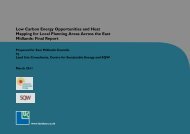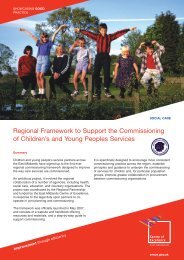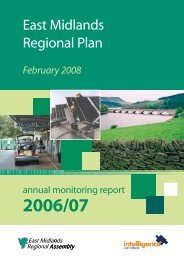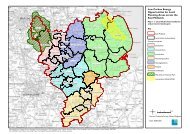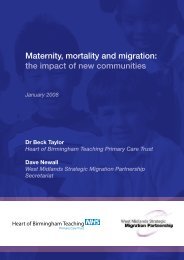East Midlands Regional Spatial Strategy 2005/06
East Midlands Regional Spatial Strategy 2005/06
East Midlands Regional Spatial Strategy 2005/06
Create successful ePaper yourself
Turn your PDF publications into a flip-book with our unique Google optimized e-Paper software.
<strong>East</strong> <strong>Midlands</strong> <strong>Regional</strong> <strong>Spatial</strong> <strong>Strategy</strong> Annual Monitoring Report <strong>2005</strong>/<strong>06</strong><br />
Data Analysis<br />
4.34 This policy area is largely concerned with the<br />
regional priorities for regeneration. Many of the<br />
regeneration initiatives have been informed by the<br />
Index of Multiple Deprivation 2004. It is not yet<br />
possible to assess the reduction in the number of<br />
districts in the <strong>East</strong> <strong>Midlands</strong> in the worst I0% most<br />
deprived as more recent comparative data are not<br />
available.There are problems in comparisons over<br />
time since the component elements of indices of<br />
deprivation tend to change. It is also likely to be the<br />
case that improvement in the deprived areas could<br />
occur, but because of improvements elsewhere, the<br />
areas remain in the worst decile.<br />
4.35 Data are provided on the proportion of<br />
development occurring in Objective 2 ESF/ERDF<br />
funded areas using this as an alternative measure of<br />
a deprived area. It would appear that the amount of<br />
development in such areas, given their land coverage<br />
in the <strong>East</strong> <strong>Midlands</strong>, is on a par with the amount of<br />
development in non Objective 2 areas.<br />
Policy Commentary<br />
4.36 The previous AMR highlighted the difficulty in<br />
monitoring the success or otherwise of this policy<br />
due to the lack of a specification of the extent of the<br />
areas concerned and the consequent problem of<br />
assigning recorded developments to them.This is<br />
one example of a number of definitional issues that<br />
the <strong>Regional</strong> Assembly recognises needs to be<br />
addressed.The use of Objective 2 areas is seen as an<br />
interim measure until this issue is fully resolved.<br />
4.37 Regeneration of the former coalfield area of<br />
north Derbyshire and north Nottinghamshire has<br />
long been viewed as a regional priority in the wake<br />
of the colliery closures.Work on Derbyshire’s<br />
£62million Markham Vale Employment Growth Zone<br />
project, centred on the former Markham Colliery,<br />
continues to gather momentum.The development’s<br />
flagship Environment Centre was officially opened in<br />
December 20<strong>06</strong> and access to the whole<br />
development via the new M1 Junction 29a is<br />
expected to be completed by December 2007.There<br />
has already been considerable interest from firms<br />
wishing to locate on the 85 hectare business park<br />
which will eventually provide 5,000 jobs.<br />
4.38 The majority of committed employment land in<br />
Derby is outside the Objective 2 area, apart from<br />
some significant sites such as Pride Park and parts of<br />
the Bombardier works which are identified for<br />
redevelopment.This is understandable in part as<br />
Objective 2 areas are generally based on the<br />
amalgamation of wards with high levels of<br />
deprivation. As such, these are largely residential<br />
areas and, while there is significant employment<br />
activity within them (e.g. the City centre, Rolls-Royce<br />
and Bombardier), there is perhaps less scope for<br />
identifying large new areas for employment<br />
development that can help meet the City’s<br />
requirements.Where opportunities do exist, e.g. Pride<br />
Park, they have been taken.<br />
4.39 Within Nottinghamshire Districts, the<br />
proportion of Objective 2 development/under<br />
construction is around that for the <strong>East</strong> <strong>Midlands</strong> as a<br />
whole.The proportion of commitments however (the<br />
vast majority of which are mixed use sites) is<br />
significantly above the <strong>Regional</strong> rate with many such<br />
sites most notably to be found in the Sutton area in<br />
Ashfield District.<br />
4.40 Northamptonshire currently does not have any<br />
of England’s 88 most deprived wards, nor is it in an<br />
Objective 2 area.The county has undertaken<br />
significant research into levels of deprivation and this<br />
has resulted in a countywide neighbourhood<br />
renewal strategy.This includes a focus to increase<br />
enterprise within deprived areas. Current policy<br />
direction on core spatial strategies within the county<br />
is clear in the need to ensure development is of<br />
benefit to both new and existing communities, with<br />
regeneration a key consideration in future<br />
development plans.<br />
48





